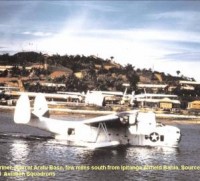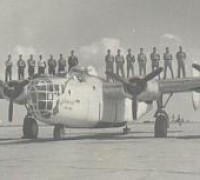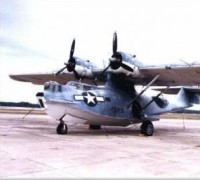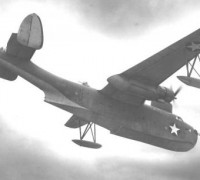U.S. NAVY VP SQUADRONS IN BRAZIL - VP SQUADRONS IN BRAZIL
18)VPB 94 - C
Cont.
The following day, 10 July 1943, VP-94 made another attack on an enemy submarine. 94-P-1 took off from Belem at 1940 Peter on convoy coverage mission. The convoy was located at 2200 Peter. Fifteen minutes later, with the plane at 1500 feet, a radar contact was obtained. The radar was switched to homing and course was changed toward the target. After one and a half minutes the plane was swung to the port in order to get around the target, the pilot made a sharp turn to starboard, starting his run from 1500 feet, distant 5 miles.
At 800 feet, three miles distant, a flare was dropped, both for illumination and to give the target, the identity of which was still in doubt, a chance to identify itself. The light was insufficient to reveal anything and the plane was then too low to release another flare. Guns had been broken out, but the crew was directed to hold its fire because of the improbability of getting any hits and the possibility of revealing the plane's position. The target was passed about one third to one half a mile to port, where a very large wake came into view, the second plot could see the vessel and identified it almost certainly as a submarine.
A 180 degree turn to port was made at about 150 feet altitude with the wake continuously in sight and an attack was carried out using the vortex of the wake as the aiming point. The plane was nosed over slightly just prior to release. Immediately afterward, the pilot looked down and saw a large, dark object in the forward part of the wake. The three members of the crew who had an opportunity to look at the wake, all of whom had been in 94-P-1 on 9 July 1943, felt that from the size of the wake it must have been a submarine.
All could see it at about half a mile on the first run. No superstructure could be picked out in the dim moonlight, but Lt.(jg) G.W.Cluff, who possibly had the best view, believed he discerned the outlines of a submarine Denauw, F.J., AMM2c, the only member of the crew who saw the explosions believes that the starboard bombs, the last to drop, exploded about 25 yards ahead of the submarine on the port side. Immediately after the drop the pilot returned to the convoy, informed the escort commander of the action and gave bearings and distance. A contact report was sent to base.
The plane returned to the attack area in ten minutes but failed to make any contact, so returned to the convoy and continued escort. At 0310 Peter 11 July, four hours and thirty five minutes after the attack, while making a radar sweep around the convoy, a wake was sighted directly below the plane at 03-02 North, 44-10 West. The plane was at 1500 feet, fifteen miles ahead of the convoy and thirty five miles from the position of the attack. The sighting was made by Lt (jg) V.L. Pendergraft who was in the pilot's seat. Lt. S.S. Deutsch returned to the pilot's seat and dropped another flare. His bombs had been expended so he hoped to force the submarine, if such it was, to submerge. Nothing was visible. Aboard the 94-P-1 were:
Pilot Lt.(jg) Saul S Deutsch, USNr, 106 268
Co-Pilot Lt.(jg) Gorden E. Harbett, USNR, 117 045
Navigator Lt.(jg) Goldwin E. Cluff, USNR, 116 297
2nd Pilot Lt.(jg) Vernon L. Pendergraft, USNR, 243 189
Tower Denauw, Frank J., AMM2c, 381 19 58
Starboard Blister Lester, William R., AOM2c, 381 31 13
Port Blister Garren, Hoyt E., ARM2c, 296 00 73
Waist hatch Smith, Elmer B., AMM3c 268 81 81, USN
Radio-Radar Watson, John H., ARM2c, 406 77 87, USN
On 20 July 1943, 94-P-14 took off at 1030 Peter from Amapa, Brazil to relieve (4-P-8 covering convoy TJ-2. The plane made a sweep ahead of the convoy. On the return leg, at 1341 Peter, the bow lookout reported a ship to port, ten o'clock, five miles. The position was 03-33 North, 48-45 West. The plot, Lt.(jg) S.E. Auslander recognized it as an enemy submarine on course about 114 true. His altitude at the time was 4000 feet. He blew the warning horn and signaled the tower to put the mixture control into auto-rich.
The plane was nosed over and a turn to port started. Meanwhile, the co-pilot turned the bombing switch on and picked up the "pickle.". As the run was started, the air was filled with bursts of smoke and tracers. During the run, the navigator ran back to the blister for the camera and the radioman started to send out the contact report. The throttles were pulled back and the plane lost altitude and picked up speed as the pilot executed several skidding turns in order to evade the gunfire. About a mile away from the sub, the pilot leveled off briefly and then pushed over again on course 240 true.
The co-pilot, on signal from the first pilot made the drop at about 100 feet and 165 knots indicated. The pilot held his course briefly after pulling out, and then made a sharp turn to port. According to the navigator, who was in the starboard blister, the drop was over. The bombs landing 30 ot 50 feet over the submarine on the starboard side and slightly ahead. The crew continued firing on the sub from blister guns and the bow gun. On scene of action voice frequency, the pilot called the escort vessels of the convoy which were close by, and at the same time the radioman was instructed to send MO's on 414 KCS.
The escort commander finally answered and was advised of the attack and position, and that the plane was sending MO's on frequency. Meanwhile the plane was still firing on the submarine, circling to port to give the port gun a chance to fire and then to starboard. The submarine continued to circle and return fire. After about 40 minutes, he started on an erratic zigzag course. At this time the plane had reached an altitude of 5000 feet, visibility was unlimited and there were no clouds. The pilot felt that the escort would be able to see the plane at that altitude.
A large wake, heading for the plane's position was observed, so course was changed toward the escort. He was approximately 20 miles away and making good speed. When the plane was half way between the sub and the escort vessel, the after-station reported the submarine starting to submerge. The pilot immediately turned and dove on it with a green fluorescent dye marker ready to mark the spot. The U-boat seemed to have difficulty submerging, as it seemed to go under, come up, go under and come up again. It finally submerged at 1445 Peter and the marker was dropped.
The plane, circling the spot, notified the escort vessels that the sub had submerged. The escort apparently discontinued his course towards the plane. The pilot started to fly a 20 mile square around the point at which the sub submerged and completed the circuit once. At 1610 Peter the plane was relieved by 94 P-12, and after indicating the spot where the dye marker was still clearly visible, the plane departed for Belem.
Although the crew thought the bombs fell over, pictures of the attack indicated a perfect straddle. The Plane expended all its ammunition strafing the submarine after the drop. In an hour time, the plane received but one hit by an explosive shrapnel shell even though it was within close gun range most of the time. The evaluation of this attack was "no damage."
94-P-14 was manned by:
Pilot Lt.(jg) Stanley E. Auslander, USNR, 104 673
Co-pilot Lt.(jg) Kenneth P. Rauer, USNR, 106 640
Navigator and Waist Hatch Lt.(jg) James K. Buckwalter, USNR, 113 065
Tower Lord, Elmer B., AMM2c, 201 72 28, USN
Bow Koszewski, Joseph A., S2c, 614 99 37, USNR
Port Waist Delorenzo, George J., AMM2c, 402 94 78
Starboard Waist Walker, Wendell L., AMM2c, 328 69 45, USN
Radio Spence, James G., ARM2c, 342 45 35, USN
The following day, 21 July 1943, 94-P-4 took off from Belem at 0230 Peter to relieve 94-P-7 on coverage of TJ-2. The plane arrived in the area and started a search for the convoy at about 0530 Peter. At 0602 Peter a submarine was sighted at 03-56 North, 48-46 West by the bow watch, distant two to three miles. It was , making six to seven knots and its deck appeared to be slightly awash with little wake showing. The plane was at 1200 feet, indicated air speed 95 knots. The pilot, Lt.(jg) R.H. Roland rolled the plane slightly to bring the sub into view.
The pilot's bombing switch was then closed and the warning horn blown. Second pilot, Lt.(jg) A.C. Anselmo manned the camera at the tunnel hatch and later at the port blister. In the second pilot's seat was Lt.(jg) Jones. The bow watch went into action to prepare the .30 calibre gun, but he was unsuccessful in freeing the barrel group to allow the breech lock to disengage. The bow gun was not cleared throughout the run. The pilot immediately turned to attack, but seeing the trouble with bow gun and encountering heavy anti-aircraft fire, veered slightly to port for about five seconds then started a shallow diving run.
Gunfire from the submarine was persistent. The rudder fin was hit at the base during the final turn. A shrapnel shot was received at the chine of the hull at the radioman's station when the plane was approximately one mile from the submarine.The run itself was routine, in that pilot successfully tried to aproximate the condition with which he had become familiar in practice bombing hops.
Fire from the sub ceased just before the drop. At the time of the drop, from an altitude of 75 feet, indicated air speed of 140-150 knots, Lt.(jg) Jones was able to view the conning tower close by to starboard. Lt.(jg) Rowland pressed the pickle, but the inboard starboard bomb hung up. From reports of the crew it seemed that charges number one and number two landed so close that they exploded almost under the port side just aft of the conning tower. During a shallow pull-out and turn to port, the bow of the submarine was seen by the pilot to be emerging from geysers of water at a very sharp angle.
The port gunner and the tower watch could both see the port bombs enter the water and viewed the start of the explosions. The starboard bomb was observed to drop to starboard of and ahead of the bow of the submarine at distance judged to be about 30 feet. The port gun was brought to bear and a full can was fired in long bursts. The pilot continued the turn for approximately one minute in order to remain in the immediate vicinity. Lt.(jg) Anselmo observed the sinking of the sub while the plane was in this turn at nearly 90 degrees to release course.
Upon re-establishing sight contact with the spot, the pilot saw no submarine, but in its place an oval oil patch which increased in size to 200 yards in length and 150-175 yards in width. Some brown streaks running through the oil-darkened area were observed by the crew. Communication difficulties were encountered because of the shrapnel hit. Photographic runs were made from all positions throughout the plane.
On the second passage over the area four survivors were sighted. Rubber life rafts were dropped and the survivors boarded them. The squadron commander believed the attack was made possible by the attack the previous day by 94-P14. It was probable, in his estimation, that the submarine was the same in both cases. This attack was assessed as "known sunk."
94-P-4 was manned by:
Pilot Lt. (jg) Richard Rowland, USNR, 112 643
Co-pilot Lt. (jg) William H. Jones, USN
Navigator (2nd Pilot) Lt. (jg) Albert G. Anselmo, USNR, 121 505
Bow Denauw, Frank J. , AMM2c, 606 19 58, USNR
Port Waist Smith, Elmer B., AMM3c, 268 81 81 , USN
Tower Wood, Ernest W. Jr., AMM3c, 269 10 18, USN
Starboard Waist Garren, Hoyt E ., ARM2c 296 00 73, USN
Radio Watson, John H., ARM2c 406 77 87, USN
Cont



